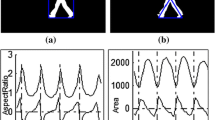Abstract
Recognizing people by gait has a unique advantage over other biometrics: it has potential for use at a distance when other biometrics might be at too low a resolution, or might be obscured. In this paper, an improved method for gait recognition is proposed. The proposed work introduces a nonlinear machine learning method, kernel Principal Component Analysis (KPCA), to extract gait features from silhouettes for individual recognition. Binarized silhouette of a motion object is first represented by four 1-D signals which are the basic image features called the distance vectors. The distance vectors are differences between the bounding box and silhouette, and extracted using four projections to silhouette. Classic linear feature extraction approaches, such as PCA, LDA, and FLDA, only take the 2-order statistics among gait patterns into account, and are not sensitive to higher order statistics of data. Therefore, KPCA is used to extract higher order relations among gait patterns for future recognition. Fast Fourier Transform (FFT) is employed as a preprocessing step to achieve translation invariant on the gait patterns accumulated from silhouette sequences which are extracted from the subjects walk in different speed and/or different time. The experiments are carried out on the CMU and the USF gait databases and presented based on the different training gait cycles. Finally, the performance of the proposed algorithm is comparatively illustrated to take into consideration the published gait recognition approaches.
Preview
Unable to display preview. Download preview PDF.
Similar content being viewed by others
References
Nixon, M.S., Carter, J.N.: Automatic Recognition by Gait. Proceeding of the IEEE 94(11), 2013–2023 (2006)
Wang, L., Tan, T., Ning, H., Hu, W.: Silhouette Analysis-Based Gait Recognition for Human Identification. IEEE Trans. on PAMI 25(12), 1505–1518 (2003)
BenAbdelkader, C., Cutler, R.G., Davis, L.S.: Gait Recognition Using Image Self-Similarity. EURASIP Journal of Applied Signal Processing 4, 1–14 (2004)
Veres, G.V., et al.: What image information is important in silhouette-based gait recognition? In: Proc. IEEE Conference on Computer Vision and Pattern Recognition vol. 2, pp. 776–782 (2004)
Huang, P., Harris, C., Nixon, M.S.: Human Gait Recognition in Canonical Space Using Temporal Templates. IEE Vision Image and Signal Processing 146, 93–100 (1999)
Han, J., Bhanu, B.: Individual Recognition Using Gait Image Energy. IEEE Trans. on Pattern Analysis and Machine Intelligence 28(2), 316–322 (2006)
Ekinci, M., Gedikli, E.: Background Estimation Based People Detection and Tracking for Video Surveillance. In: Yazıcı, A., Şener, C. (eds.) ISCIS 2003. LNCS, vol. 2869, pp. 421–429. Springer, Heidelberg (2003)
Sarkar, S., et al.: The HumanID Gait Challenge Problem: Data Sets, Performance, and Analysis. IEEE Transactions on Pattern Analaysis and Machine Intelligence 27(2), 162–177 (2005)
Kale, A., et al.: Identification of Humans Using Gait. IEEE Transactions on Image Processing 13(9), 1163–1173 (2004)
Kale, A., Cuntoor, N., Chellappa, R.: A Framework for Activity Specific Human Identification. In: IEEE International Conference on Acoustics, Speech, and Signal Processing, vol. 4, pp. 3660–3663 (2002)
Kale, A., Rajagopalan, A., Cuntoor, N., Krugger, V.: Gait-Based Recognition of Humans Using Continuous HMMMs. In: IEEE International Conference on Automatic Face and Gesture Recognition, pp. 321–326 (2002)
Yanxi, L., Collins, R.T., Tsin, T.: Gait Sequence Analysis using Frieze Patterns. In: Heyden, A., Sparr, G., Nielsen, M., Johansen, P. (eds.) ECCV 2002. LNCS, vol. 2351, pp. 657–671. Springer, Heidelberg (2002)
BenAbdelkader, C., Cutler, R., Davis, L.: Motion-Based Recognition of People in Eigengait Space. In: IEEE International Conference on Automatic Face and Gesture Recognition, pp. 254–259 (2002)
Collins, R., Gross, R.J., Shi, J.: Silhouette-Based Human Identification from Body Shape and Gait. In: IEEE International Conference on Automatic Face and Gesture Recognition, pp. 351–356 (2002)
Scholkopf, B., Somala, A.J.: Learning with Kernel: Support Vector Machine, Regularization, Optimization and Beyond. MIT Press, Cambridge (2002)
Ali, S., Shah, M.: A Supervised Learning Framework for Generic Object Detection. In: IEEE International Conference on Computer Vision, vol. 2, pp. 1347–1354 (2005)
Ekinci, M., Gedikli, E.: Silhouette-Based Human Motion Detection and Analysis for Real-Time Automated Video Surveillance. Turkish Journal of Electrical Engineering and Computer Sciences 13(2), 199–230 (2005)
Gross, R., Shi, J.: The CMU motion of body (MOBO) database. Tech. Rep. CMU-RI-TR-01-18, Robotics Institute, Carnegie Mellon University (2001)
Lee, L., Grimson, W.: Gait Analysis for Recognition and Classification. In: IEEE Proc. Int. Conference on Automatic Face and Gesture Recognition, pp. 155–162 (2002)
Murat, E.: A New Attempt to Silhouette-Based Gait Recognition for Human Identification. In: Lamontagne, L., Marchand, M. (eds.) Canadian AI 2006. LNCS (LNAI), vol. 4013, pp. 443–454. Springer, Heidelberg (2006)
Bazin, A.I., Nixon, M.S.: Gait Verification Using Probabilistic Methods. In: IEEE Workshop on Applications of Computer Vision, pp. 60–65 (2005)
Phillips, P., et al.: Baseline Results for the Challenge Problem of Human ID using Gait Analysis. In: IEEE International Conference on Automatic Face and Gesture Recognition, pp. 130–135 (2002)
Zhu, Y., Tan, T.: Biometric Personal Identification Based on Handwriting. Pattern Recognition (2), 797–800 (2000)
Author information
Authors and Affiliations
Editor information
Rights and permissions
Copyright information
© 2007 Springer-Verlag Berlin Heidelberg
About this paper
Cite this paper
Ekinci, M., Aykut, M., Gedikli, E. (2007). Gait Recognition by Applying Multiple Projections and Kernel PCA. In: Perner, P. (eds) Machine Learning and Data Mining in Pattern Recognition. MLDM 2007. Lecture Notes in Computer Science(), vol 4571. Springer, Berlin, Heidelberg. https://doi.org/10.1007/978-3-540-73499-4_55
Download citation
DOI: https://doi.org/10.1007/978-3-540-73499-4_55
Publisher Name: Springer, Berlin, Heidelberg
Print ISBN: 978-3-540-73498-7
Online ISBN: 978-3-540-73499-4
eBook Packages: Computer ScienceComputer Science (R0)




